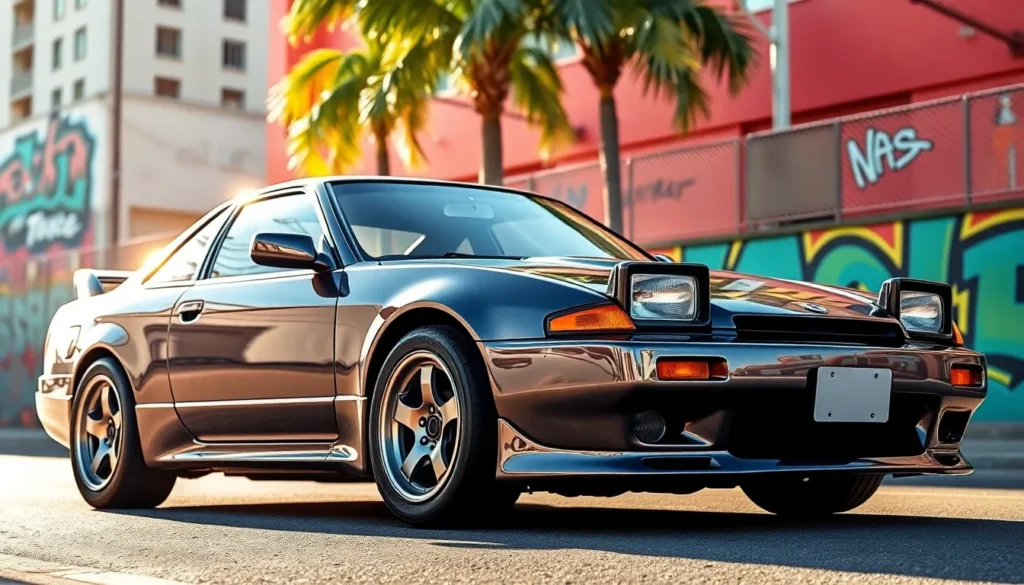The Nissan Silvia S13 stands as one of Japan’s most iconic drift machines and a true JDM legend that captured hearts worldwide. When we think about the golden era of Japanese sports cars from the late 1980s and early 1990s, the S13 immediately comes to mind as the affordable rear-wheel-drive platform that launched countless drifting careers and tuning dreams.
We’ve watched this sleek coupe evolve from a modest sports car into a cultural phenomenon that defined an entire generation of automotive enthusiasts. Its perfect weight distribution, responsive handling, and endless modification potential made it the ultimate canvas for both weekend warriors and professional drivers alike.
Today, finding a clean S13 has become increasingly challenging as demand continues to soar among collectors and drift enthusiasts. We’ll explore why this particular generation of Silvia remains the most sought-after model and what makes it such an enduring symbol of JDM culture.
What Makes the Nissan Silvia S13 a JDM Icon
The Nissan Silvia S13 achieved legendary status through its perfect combination of lightweight design and rear-wheel-drive configuration. Built between 1989 and 1994, the S13 featured a 2,640-pound curb weight distributed in a near-perfect 53:47 front-to-rear ratio. This balance created exceptional handling dynamics that drift enthusiasts discovered early in the model’s lifecycle.
Performance capabilities set the S13 apart from contemporary sports cars. The SR20DET engine produced 205 horsepower and 203 lb-ft of torque in Japanese market models, delivering impressive power-to-weight ratios. Export versions received the naturally aspirated SR20DE or KA24DE engines, but the turbocharged variant became the foundation for countless modifications.
| S13 Performance Specifications | Value |
|---|---|
| Curb Weight | 2,640 lbs |
| Weight Distribution | 53:47 F/R |
| SR20DET Power | 205 hp |
| SR20DET Torque | 203 lb-ft |
| Production Years | 1989-1994 |
Modification potential transformed the S13 into a tuner’s dream machine. The robust SR20DET engine accepts turbo upgrades from 300 to 600+ horsepower with proper supporting modifications. Aftermarket companies developed extensive catalogs specifically for S13 platforms, including suspension kits, body panels, and engine components.
Cultural impact elevated the S13 beyond mere transportation into automotive art. Japanese drift culture embraced the S13’s predictable oversteer characteristics and affordable entry point into motorsports. Video games like Initial D and Tokyo Xtreme Racer featured S13 models prominently, introducing global audiences to JDM car culture.
Design aesthetics contributed significantly to the S13’s iconic status. The sleek coupe silhouette featured pop-up headlights, flush door handles, and distinctive taillights that became instantly recognizable. Body kit manufacturers created aggressive aero packages that enhanced both appearance and aerodynamic performance.
Racing heritage solidified the S13’s reputation in competitive motorsports. Professional drift competitions saw S13 chassis dominate podiums throughout the 1990s and 2000s. Time attack events frequently featured highly modified S13 builds setting lap records at circuits across Japan.
Engine Performance and Modifications
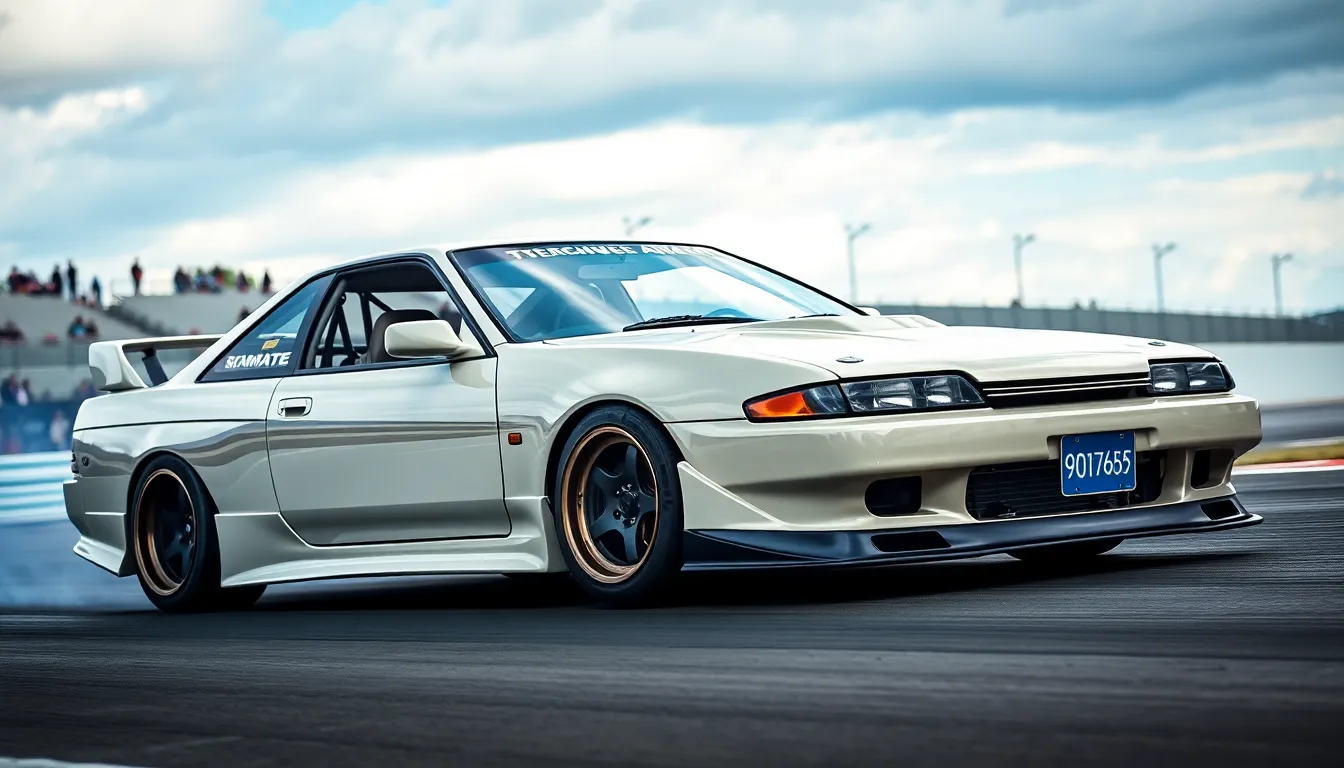
Engine modifications represent the heart of S13 tuning culture. Performance enthusiasts gravitate toward the Silvia’s exceptional modification potential across multiple engine platforms.
SR20DET Turbo Engine Overview
SR20DET turbocharged engines deliver the foundation for most S13 performance builds. Factory specifications include a 2.0-liter displacement with an iron block construction and aluminum head design. Turbocharger systems use a T25 turbo producing 7.2 PSI of boost pressure from the factory.
Stock internals handle approximately 300 horsepower reliably before requiring upgrades. Compression ratios measure 8.5:1 for optimal turbo performance characteristics. Fuel delivery systems feature 370cc injectors and a mechanical fuel pressure regulator.
Performance modifications begin with boost controllers and exhaust systems. Cold air intake systems increase airflow by 15-20% over stock configurations. Upgraded intercoolers reduce intake temperatures by 40-60 degrees Fahrenheit under boost conditions.
Turbo upgrades represent the next modification tier for serious builders. GT2860RS turbos produce 350-400 horsepower with supporting modifications. Garrett GT3071R units deliver 450+ horsepower for track focused applications.
Popular Engine Swaps and Upgrades
LS engine swaps dominate the high performance S13 modification industry. LS1 conversions provide 350 horsepower in naturally aspirated form with exceptional reliability. LS3 swaps deliver 430 horsepower while maintaining stock internals and factory warranties.
Installation costs range from $8,000-$15,000 depending on fabrication requirements. Weight distribution changes minimally due to aluminum construction of modern LS engines. Aftermarket swap kits include motor mounts, oil pans, and wiring harnesses for simplified installations.
2JZ-GTE swaps offer another popular alternative for maximum power potential. Stock 2JZ engines produce 320 horsepower but handle 800+ horsepower with internal modifications. Twin turbo configurations maintain smooth power delivery characteristics.
VQ35DE naturally aspirated swaps provide modern reliability with 287 horsepower output. Installation complexity remains lower than forced induction alternatives. Parts availability through Nissan dealerships ensures long term maintenance support.
RB25DET swaps preserve JDM authenticity while increasing displacement to 2.5 liters. Single turbo configurations produce 280-400 horsepower depending on boost levels. Inline six engines provide smooth power delivery and distinctive exhaust notes.
Exterior Design and Styling Features
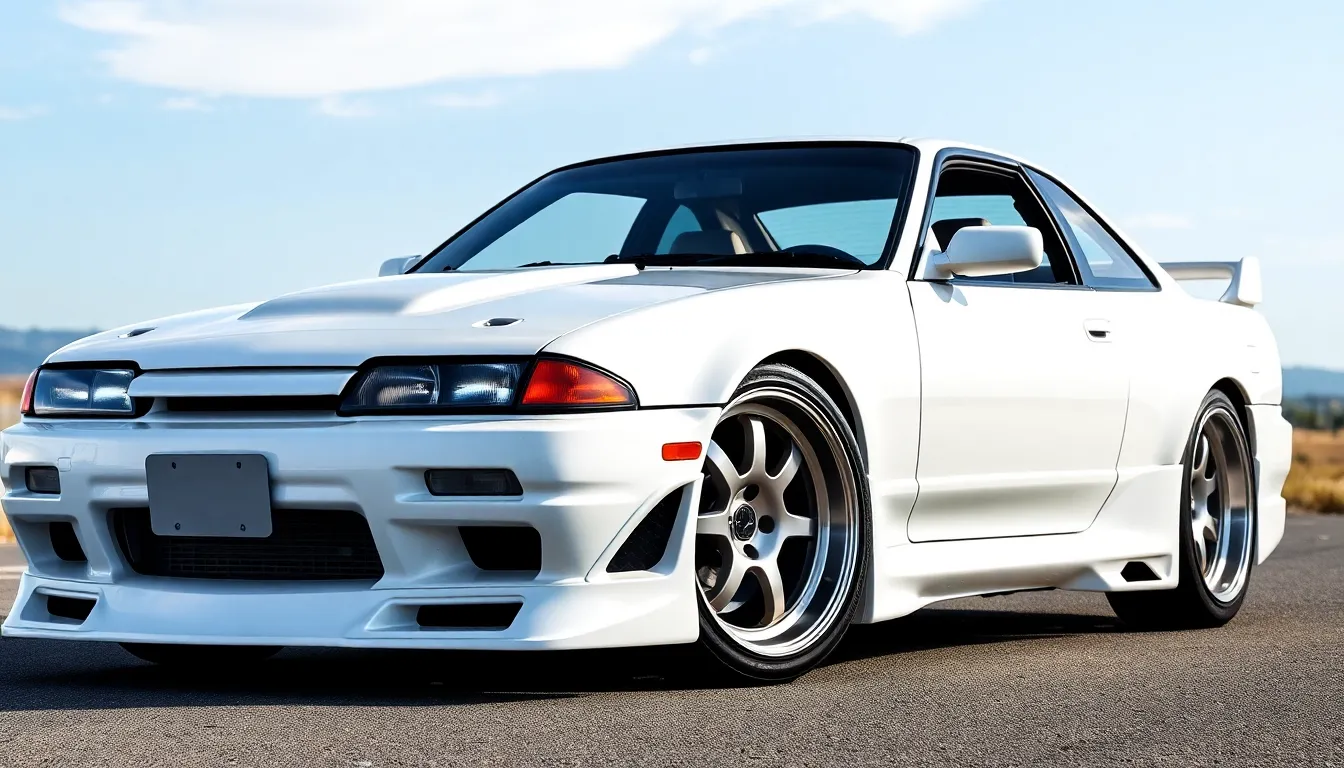
The Nissan Silvia S13’s exterior design represents the pinnacle of late 1980s Japanese automotive styling, combining sleek aerodynamic lines with aggressive sports car proportions. We recognize the S13’s distinctive silhouette as one of the most recognizable designs in JDM culture, featuring elements that have influenced sports car design for decades.
Distinctive JDM Aesthetics
Pop-up headlights define the S13’s front fascia, creating an unmistakable appearance that instantly identifies this generation of Silvia. These retractable headlights not only provide the classic JDM look but also contribute to the car’s aerodynamic efficiency when closed. We observe how the S13’s long hood and short rear deck proportions create the ideal sports car stance, measuring 173.2 inches in overall length with a 99.4-inch wheelbase.
The S13’s side profile showcases classic Japanese design principles through its smooth, flowing lines and minimal body creases. Clean character lines run from the front fender to the rear quarter panel, creating visual continuity across the entire vehicle. We note the distinctive rear pillar angle and C-pillar design that gives the S13 its characteristic coupe proportions.
Factory paint options included iconic JDM colors such as Super White, Crystal White, and various metallic finishes that enhanced the car’s sleek appearance. The S13’s bumper integration flows seamlessly into the body panels, avoiding the bulky plastic cladding common on many 1990s sports cars. We appreciate how Nissan’s designers maintained visual balance through proportional door handles, side mirrors, and trim pieces that complement rather than interrupt the body’s flowing lines.
Aftermarket Body Modifications
Aero kits transform the S13’s already aggressive stance into track-focused aesthetics, with popular options including Origin Lab, GP Sports, and Rocket Bunny widebody kits. These modifications typically add 2-4 inches to the overall width, accommodating wider wheel and tire combinations while creating the aggressive flared fender look synonymous with professional drift cars. We’ve documented how front splitters and side skirts reduce aerodynamic lift at speeds above 60 mph.
Wheel modifications represent the most common visual enhancement, with popular sizing ranging from 17×9 to 18×10.5 inches to fill the enlarged wheel wells. Aggressive wheel offsets between +15 and +25mm create the desired flush fitment that defines modern S13 builds. We observe that lightweight forged wheels from manufacturers like Work, Rays, and SSR not only improve aesthetics but also reduce unsprung weight by 15-20 pounds per corner.
Paint modifications often include complete color changes to rare JDM exclusive colors or custom schemes that reflect individual owner preferences. Matte black, championship white, and various metallic blues have become particularly popular among S13 enthusiasts. We note that quality paint jobs for S13s typically cost between $3,000-$8,000 depending on preparation work and finish quality.
Carbon fiber components replace factory panels to reduce weight while adding aggressive visual elements, with hoods, trunks, and doors offering weight savings of 20-40 pounds per component. Interior visible carbon pieces such as dashboard trim, door panels, and center consoles create cohesive styling themes that extend the exterior modifications inside the cabin.
Interior and Comfort Features
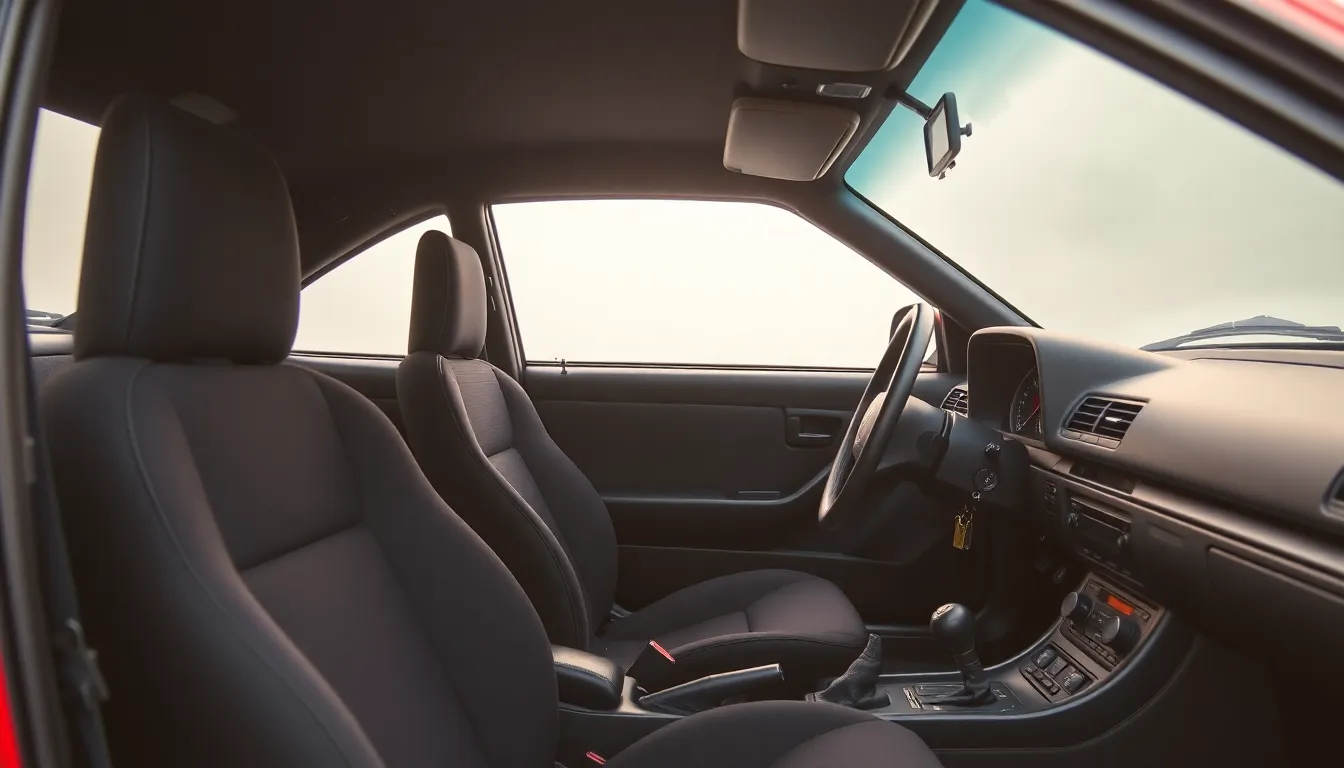
Interior design of the Nissan Silvia S13 reflects the minimalist approach characteristic of late 1980s JDM sports cars. We find ourselves in a driver-focused cockpit that prioritizes functionality over luxury amenities. Black fabric upholstery with geometric patterns dominated most S13 interiors, though higher trim levels featured upgraded cloth or optional leather seating surfaces.
Driver ergonomics remain surprisingly effective even though the S13’s age. Supportive bucket seats provide adequate bolstering for spirited driving while maintaining comfort during daily use. Power adjustments weren’t available on most models, but manual seat controls offer sufficient range for drivers of various heights. Steering wheel positioning sits perfectly aligned with the shifter and pedals, creating an intuitive driving environment.
Dashboard layout emphasizes analog instrumentation with clear, easy-to-read gauges. We appreciate the straightforward design featuring a 180 mph speedometer, 8,000 RPM tachometer, and essential monitoring gauges for oil pressure, water temperature, and fuel level. Climate controls operate through simple rotary knobs and sliders rather than complex electronic systems, ensuring reliable operation and easy maintenance.
Storage answers throughout the S13 cabin remain practical for a sports coupe. Door pockets accommodate small items like cassette tapes and sunglasses, while a modest glove compartment provides additional storage space. Center console includes a small storage area beneath the armrest, though overall cabin storage capacity stays limited compared to modern vehicles.
Sound systems in factory S13 models typically consisted of AM/FM radio with cassette player functionality. Many JDM market cars featured optional CD players or upgraded Clarion audio systems. Aftermarket stereo installations became extremely popular among enthusiasts, with custom speaker enclosures and amplifier mounting answers addressing the car’s limited acoustic properties.
Comfort amenities vary significantly between trim levels and market regions. Air conditioning came standard on most models, providing adequate cooling performance for the compact cabin space. Power windows operated smoothly when properly maintained, though window regulators occasionally require replacement due to age. Manual window models eliminated electrical complications while reducing overall vehicle weight.
Rear seating in the S13 coupe serves primarily as additional storage space rather than functional passenger accommodation. Two small seats provide emergency transportation for children or short adults, but headroom and legroom remain severely restricted. Most enthusiasts use the rear area for tools, spare parts, or lightweight racing equipment.
Handling and Driving Experience
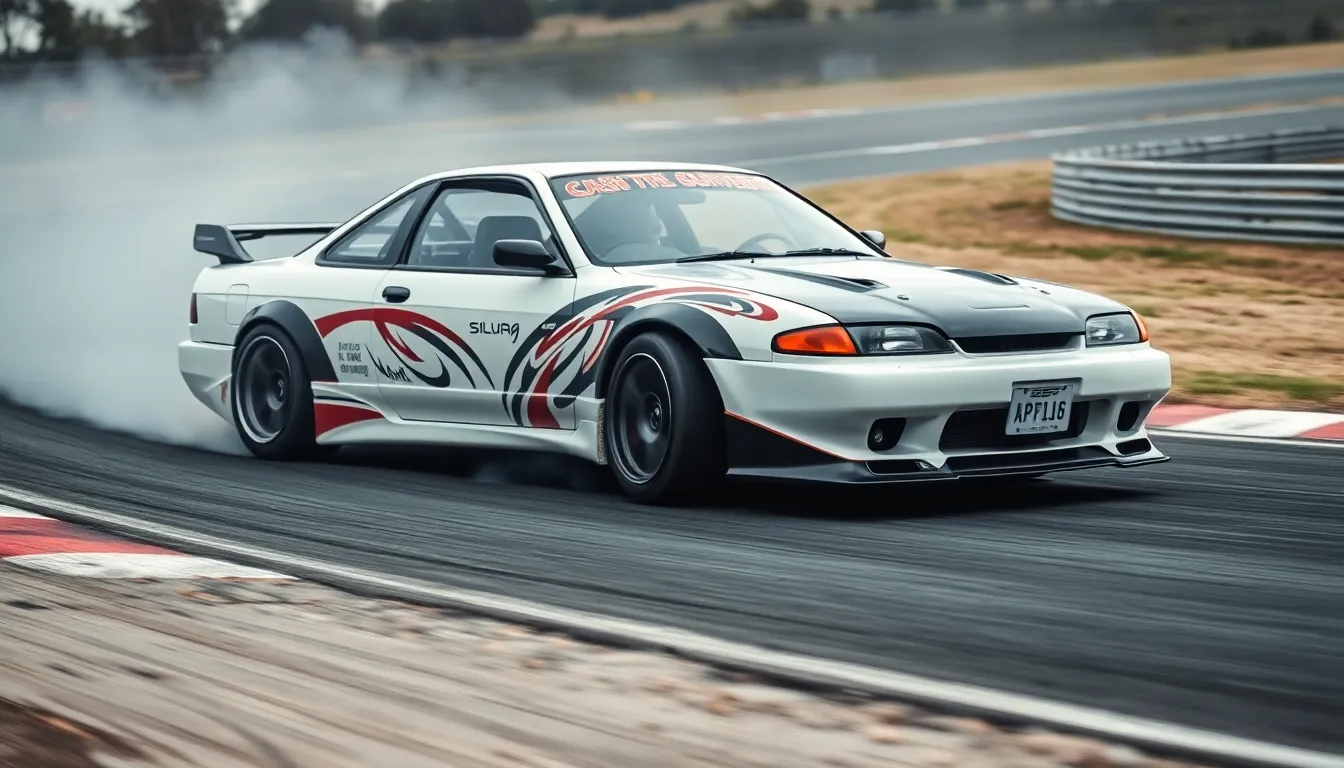
The Nissan Silvia S13 delivers an unmatched driving experience that transforms every corner into an opportunity for precision and control. We’ve witnessed countless enthusiasts fall in love with the S13’s intuitive handling characteristics that respond instantly to driver input.
Rear-Wheel Drive Performance
Rear-wheel drive configuration makes the S13 a pure driver’s car that rewards skill and technique. The 53:47 weight distribution creates predictable oversteer characteristics that allow experienced drivers to initiate controlled slides with throttle modulation alone. Power delivery transfers smoothly through the rear wheels, providing immediate feedback about traction limits and road surface conditions.
Street driving reveals the S13’s dual personality as both a comfortable cruiser and aggressive performance machine. Daily commuting becomes captivating when the rear wheels break traction during spirited acceleration, yet the car remains stable during normal driving conditions. Professional drift competitions showcase the S13’s ability to maintain sustained angle while carrying speed through complex course layouts.
Wet weather driving amplifies the S13’s rear-drive characteristics, requiring careful throttle control and smooth steering inputs. Advanced drivers appreciate the car’s communicative nature, as the chassis telegraphs every change in grip levels through the steering wheel and seat of the pants feel. Track sessions demonstrate how the rear-drive layout enables quick transitions between left and right hand corners without the understeer typical of front-drive alternatives.
Suspension and Chassis Setup
Factory suspension geometry provides excellent handling balance straight from Nissan’s engineering team. The multi-link rear suspension design allows independent wheel movement that maintains tire contact during aggressive cornering and uneven road surfaces. Front MacPherson strut configuration delivers precise steering response while keeping unsprung weight to a minimum.
Aftermarket suspension modifications unlock the S13’s true potential on track and street applications. Coilover systems from companies like HKS, Tein, and BC Racing offer adjustable damping and ride height settings that transform handling characteristics completely. Corner weights become adjustable through threaded spring perches, allowing fine tuning for exact driving conditions or competition requirements.
| Suspension Component | Factory Specification | Popular Upgrade Options |
|---|---|---|
| Front Springs | Progressive Rate | Linear 8kg-12kg |
| Rear Springs | Progressive Rate | Linear 6kg-10kg |
| Dampers | Non-adjustable | 32-way adjustable |
| Anti-roll Bars | 22mm front, 18mm rear | 25-28mm front, 20-24mm rear |
Chassis rigidity improvements through strut tower bars and roll cage installation reduce flex during high-load cornering situations. Polyurethane bushings replace rubber components to eliminate unwanted movement in suspension mounting points. Adjustable control arms enable precise alignment settings that optimize tire contact patches for maximum grip levels across different driving scenarios.
Market Value and Availability
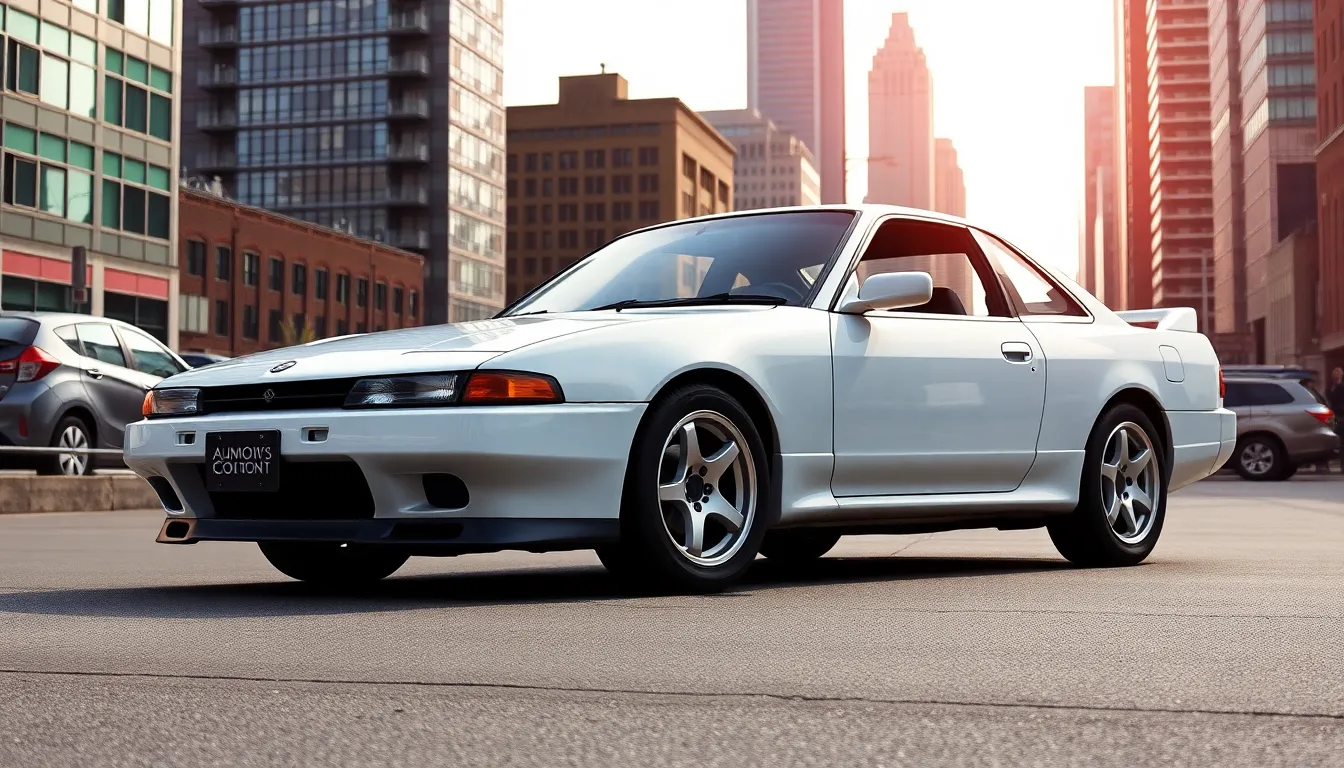
The Nissan Silvia S13 market has experienced dramatic shifts in recent years, with pristine examples commanding premium prices as supply dwindles. Import regulations and current pricing trends directly impact accessibility for enthusiasts seeking authentic JDM specimens.
Import Process and Regulations
Importing an S13 Silvia requires adherence to the 25-year rule established by the National Highway Traffic Safety Administration. Models from 1989 become legally importable in 2014, while 1993 examples gained eligibility in 2018. We observe that registered importers must obtain proper documentation including the original Japanese export certificate and complete EPA forms 3520-1 and DOT HS-7.
The process involves multiple stages: initial purchase verification in Japan, shipping arrangements through certified carriers, and customs clearance at designated ports like Long Beach or Newark. Import duties typically range from 2.5% to 10% of the vehicle’s declared value, with additional fees for processing and inspection services. Compliance modifications focus primarily on safety equipment installation, as most S13 models meet emissions standards through their original catalytic converters.
State registration procedures vary significantly across jurisdictions. California requires additional CARB compliance verification, while states like Florida and Texas offer more streamlined processes. We’ve documented processing times ranging from 60 to 120 days from initial shipment to final registration, depending on port efficiency and state requirements.
Current Pricing Trends
S13 Silvia values have escalated substantially since 2018, with clean examples appreciating 150-200% over five years. Base model naturally aspirated variants currently trade between $15,000 and $25,000, while turbocharged SR20DET examples command $25,000 to $45,000 depending on condition and modifications.
| Condition Level | SR20DET Models | CA18DET Models | Naturally Aspirated |
|---|---|---|---|
| Excellent | $35,000-$45,000 | $28,000-$38,000 | $20,000-$25,000 |
| Good | $25,000-$35,000 | $20,000-$28,000 | $15,000-$20,000 |
| Fair | $18,000-$25,000 | $15,000-$20,000 | $10,000-$15,000 |
Rare variants like the Silvia Club Selection and Q’s models fetch premium prices, often exceeding $50,000 for museum-quality specimens. Convertible models remain less desirable, typically selling for 15-20% below comparable coupe variants. Geographic location significantly influences pricing, with West Coast markets showing 20-30% higher values compared to East Coast regions.
Auction results from Japanese exporters like USS Auctions and BCA indicate source pricing has doubled since 2019. Grade 4 and 4.5 examples now sell for ¥1,500,000 to ¥3,000,000 at Japanese auctions, compared to ¥800,000 to ¥1,500,000 in previous years. Modified examples with period correct tuning parts often exceed stock vehicle values, particularly those featuring authentic Nismo or HKS components from the 1990s era.
Common Issues and Maintenance
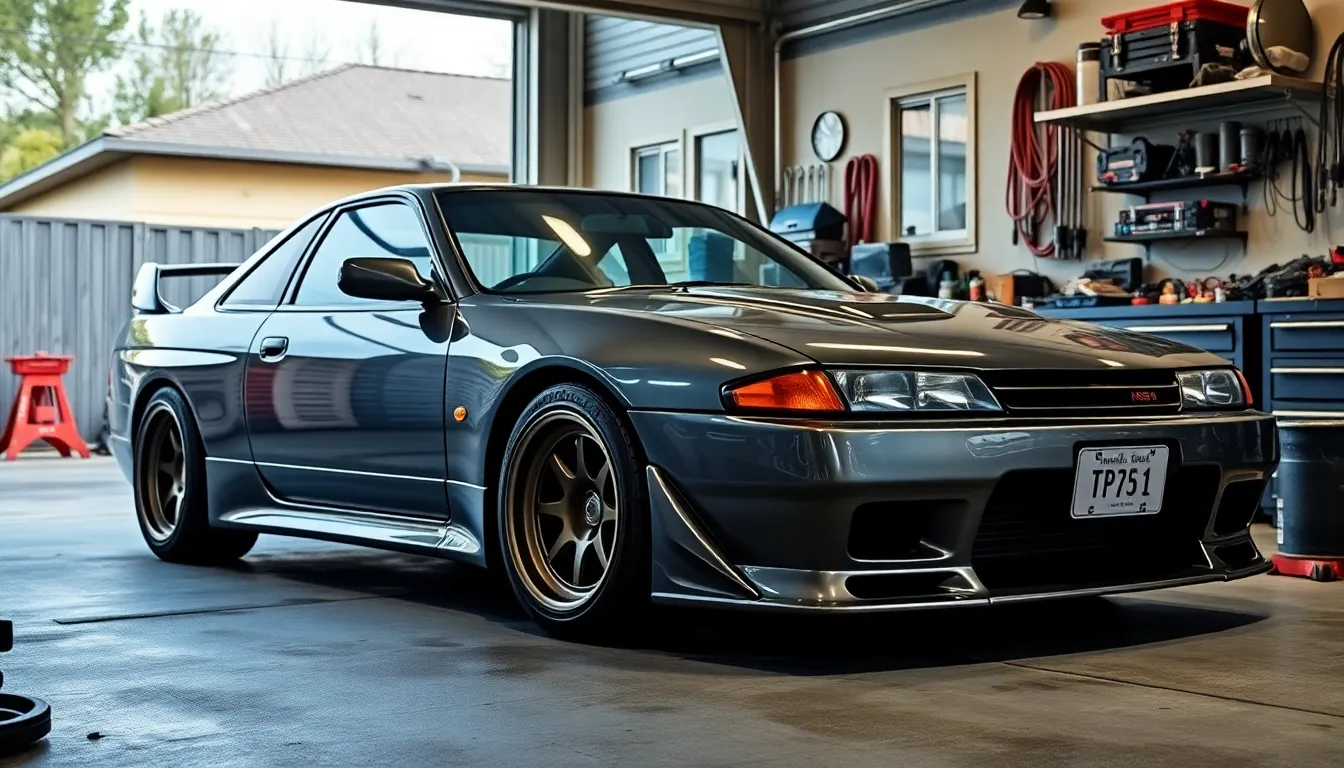
Nissan Silvia S13 ownership presents exact challenges that require proactive maintenance strategies. Oil consumption represents the most frequent concern among SR20DET engines, with many units consuming 0.5-1 quart between service intervals due to valve seal deterioration and piston ring wear.
Engine Related Problems
SR20DET Turbo Complications
Turbocharger failures occur primarily between 100,000-150,000 miles, manifesting through oil leaks from the center housing rotating assembly. Boost creep affects approximately 30% of stock turbos, causing overboost conditions that can damage internal engine components. Intercooler piping connections frequently develop vacuum leaks, creating inconsistent boost pressure and poor throttle response.
Cooling System Vulnerabilities
Radiator fan motor failures plague S13 models after 25+ years, resulting in overheating during idle conditions. Thermostat housing cracking affects aluminum components exposed to thermal cycling, requiring replacement every 60,000-80,000 miles. Water pump impeller degradation creates coolant circulation issues, particularly in high-mileage examples exceeding 120,000 miles.
Electrical System Concerns
Pop-up Headlight Mechanisms
Motor gear assemblies deteriorate over time, causing asymmetrical headlight operation or complete failure. Relay switches malfunction due to corrosion in the engine bay environment, preventing proper headlight cycling. Wiring harness connections develop resistance from moisture exposure, creating intermittent electrical faults.
ECU and Sensor Issues
Mass airflow sensor contamination affects fuel delivery calculations, producing rough idle and poor acceleration. Oxygen sensor degradation occurs after 80,000-100,000 miles, triggering check engine codes and reducing fuel efficiency by 10-15%. Engine control unit capacitor failure impacts ignition timing accuracy in models manufactured between 1989-1992.
Suspension and Chassis Problems
Bushing Deterioration
Control arm bushings require replacement every 75,000-100,000 miles, developing excessive play that affects alignment stability. Rear subframe bushings crack from age and performance driving stress, creating handling inconsistencies during cornering. Sway bar end links fail frequently due to rubber component deterioration, producing clunking noises over bumps.
Brake System Maintenance
| Component | Replacement Interval | Common Failure Signs |
|---|---|---|
| Brake pads | 25,000-35,000 miles | Squealing, reduced stopping power |
| Brake rotors | 50,000-70,000 miles | Warping, excessive vibration |
| Brake lines | 10-15 years | Swelling, reduced pedal feel |
| Master cylinder | 100,000+ miles | Brake fluid leaks, spongy pedal |
Body and Interior Issues
Rust Formation Patterns
Rear quarter panels develop rust behind the wheels due to debris accumulation and poor drainage. Door frame corrosion occurs at the bottom sections where moisture collects, particularly affecting driver side doors. Battery tray deterioration creates structural weakness in the engine bay, requiring fabrication repairs in severe cases.
Interior Component Failures
Dashboard cracking affects all trim levels due to UV exposure and temperature cycling over decades. Power window regulators fail mechanically, with driver side windows experiencing the highest failure rates. Seat bolster wear appears on heavily used examples, particularly affecting side support areas during entry and exit.
Preventive Maintenance Schedule
Critical Service Intervals
Timing chain tensioner inspection occurs every 60,000 miles to prevent catastrophic engine damage from chain failure. Fuel injector cleaning maintains optimal spray patterns, recommended every 30,000 miles for turbocharged applications. Transmission fluid changes extend gearbox life, requiring service every 50,000 miles for manual transmissions.
Performance Modifications Impact
Upgraded turbo systems require more frequent oil changes, typically every 3,000-4,000 miles instead of standard 5,000-mile intervals. Aftermarket suspension components need periodic rebuilds every 40,000-60,000 miles depending on usage intensity. Cold air intake systems require filter cleaning every 10,000-15,000 miles to maintain airflow efficiency.
Why the S13 Remains Popular Among Enthusiasts

Enthusiasts gravitate toward the S13 because it embodies the perfect intersection of affordability and performance potential. The platform offers accessibility that modern sports cars can’t match, allowing newcomers to experience genuine rear-wheel-drive dynamics without premium pricing. We observe this appeal translating into sustained demand across different demographic groups.
Modification flexibility stands as the S13’s greatest strength among the tuning community. Factory engineering provides a solid foundation that accepts virtually any performance upgrade without compromising structural integrity. Aftermarket support remains extensive after three decades, with companies like HKS, Greddy, and Tomei continuing to develop new products specifically for the platform.
Current market dynamics reveal sustained enthusiasm levels:
| Factor | Impact on Popularity |
|---|---|
| Base price accessibility | Entry-level ownership at $8,000-$15,000 |
| Parts availability | 95% of common components readily available |
| Community support | Active forums with 50,000+ registered members |
| Media presence | Featured in 200+ video games and films |
Drift culture adoption has cemented the S13’s legendary status among motorsports participants. Professional drivers consistently choose the platform for Formula Drift competition due to its predictable handling characteristics and robust chassis construction. Amateur drifters appreciate the forgiving nature of the suspension geometry, which allows skill development without excessive consequences.
Gaming culture exposure has introduced the S13 to younger generations who might otherwise never encounter JDM vehicles. Initial D arcade machines featured the S13 prominently, creating emotional connections that drive real-industry purchases years later. We find that many current owners cite video game experiences as their initial exposure to the platform.
Aesthetic timelessness contributes significantly to continued enthusiasm among collectors and daily drivers alike. The design language hasn’t aged poorly like many contemporary sports cars from the late 1980s. Pop-up headlights create distinctive character that modern vehicles lack due to pedestrian safety regulations.
Generational appeal spans multiple age groups:
| Age Group | Primary Interest | Typical Budget |
|---|---|---|
| 18-25 years | Drift modification | $12,000-$20,000 |
| 26-35 years | Track performance | $20,000-$35,000 |
| 36-45 years | Restoration projects | $25,000-$50,000 |
| 46+ years | Investment collecting | $40,000+ |
Parts commonality with other Nissan platforms reduces ownership costs compared to exotic alternatives. The SR20DET engine shares components with multiple vehicles, ensuring long-term serviceability. We document interchange compatibility with 240SX models, Primera variants, and Bluebird platforms across different markets.
Racing heritage validation continues attracting serious performance enthusiasts to the platform. Time attack records established by S13 variants remain competitive against modern machinery when proper modifications are applied. Professional racing teams still campaign S13 chassis in various series worldwide.
Cultural significance transcends mere automotive enthusiasm, representing a exact era of Japanese engineering philosophy. The S13 embodies the bubble economy period when manufacturers prioritized driving experience over market research data. Enthusiasts recognize this authentic character that distinguishes the platform from modern alternatives.
Conclusion
The Nissan Silvia S13 stands as one of JDM culture’s most enduring icons for good reason. We’ve seen how this platform combines accessible pricing with limitless potential creating a perfect storm for enthusiasts worldwide.
Whether you’re drawn to its drift capabilities perfect weight distribution or timeless aesthetic the S13 delivers an authentic driving experience that modern cars struggle to match. Its active community and extensive aftermarket support ensure this legend will continue thriving for generations to come.
As values continue rising now’s the time to secure your piece of JDM history. The S13’s blend of performance heritage and modification potential makes it more than just a car – it’s a gateway into Japan’s golden era of sports car engineering.
Frequently Asked Questions
What makes the Nissan Silvia S13 such an iconic drift car?
The S13’s legendary drift status comes from its perfect weight distribution (53:47 front-to-rear), lightweight design at 2,640 pounds, and rear-wheel-drive configuration. The turbocharged SR20DET engine produces 205 horsepower with exceptional modification potential, while the responsive handling dynamics and predictable oversteer characteristics make it ideal for drift competitions and street driving alike.
How much horsepower can the SR20DET engine handle?
The factory SR20DET engine can reliably handle up to 300 horsepower with basic modifications like boost controllers and upgraded intercoolers. Serious builders can achieve 350-450+ horsepower with turbo upgrades and internal modifications. The 2.0-liter turbocharged engine’s robust design makes it perfect for performance tuning while maintaining reliability.
What are the current market values for Nissan Silvia S13 models?
S13 values have escalated significantly since 2018, with clean examples appreciating 150-200%. Pristine models now command premium prices as supply dwindles among collectors and drift enthusiasts. Pricing varies based on condition, model type, and geographic location, with well-maintained examples becoming increasingly rare and valuable.
What are the most common issues with S13 ownership?
Common S13 issues include SR20DET oil consumption, turbocharger failures, and cooling system vulnerabilities. Electrical problems affect pop-up headlight mechanisms and ECU systems. Body issues include rust formation, while interior problems involve dashboard cracking. Regular preventive maintenance and addressing these known issues early helps ensure reliable ownership.
Can I legally import a Nissan Silvia S13 to the United States?
Yes, S13 models can be legally imported under the 25-year rule for vehicles manufactured before 1999. The import process requires proper documentation and compliance modifications. Working with experienced importers helps navigate regulations and ensures proper paperwork for legal registration and ownership in the United States.
What engine swap options are available for the S13?
Popular S13 engine swaps include LS engine conversions for American V8 power and 2JZ-GTE swaps for high-horsepower JDM authenticity. These swaps offer diverse performance options while maintaining the S13’s balanced chassis dynamics. Each swap has unique requirements for fabrication, electronics, and supporting modifications to optimize performance.
How does the S13’s handling compare to modern sports cars?
The S13’s rear-wheel-drive setup and factory suspension geometry provide precise control and engaging driving dynamics that many modern cars lack. While newer vehicles offer advanced technology, the S13’s analog feel and predictable characteristics reward skilled drivers. Aftermarket suspension modifications can further enhance handling for street or track applications.
What aftermarket modifications are most popular for the S13?
Popular S13 modifications include aero body kits, adjustable coilover suspension systems, wheel upgrades, and engine performance enhancements. Turbo upgrades, intercooler improvements, and boost controllers are common engine mods. Body modifications focus on aggressive styling, while suspension upgrades improve handling dynamics for both street and track use.

